Given the robust nature of learning sciences research, this website is best viewed on tablets and computers. A small screen experience is coming in the future.
On June 22, 2021, we will launch updated strategies for the Math PK-2 model, as well as additional updates to the Navigator that highlight equity, SEL, and culturally responsive teaching. To learn more, visit our Site Updates (available in the "About" menu at the top of any page).
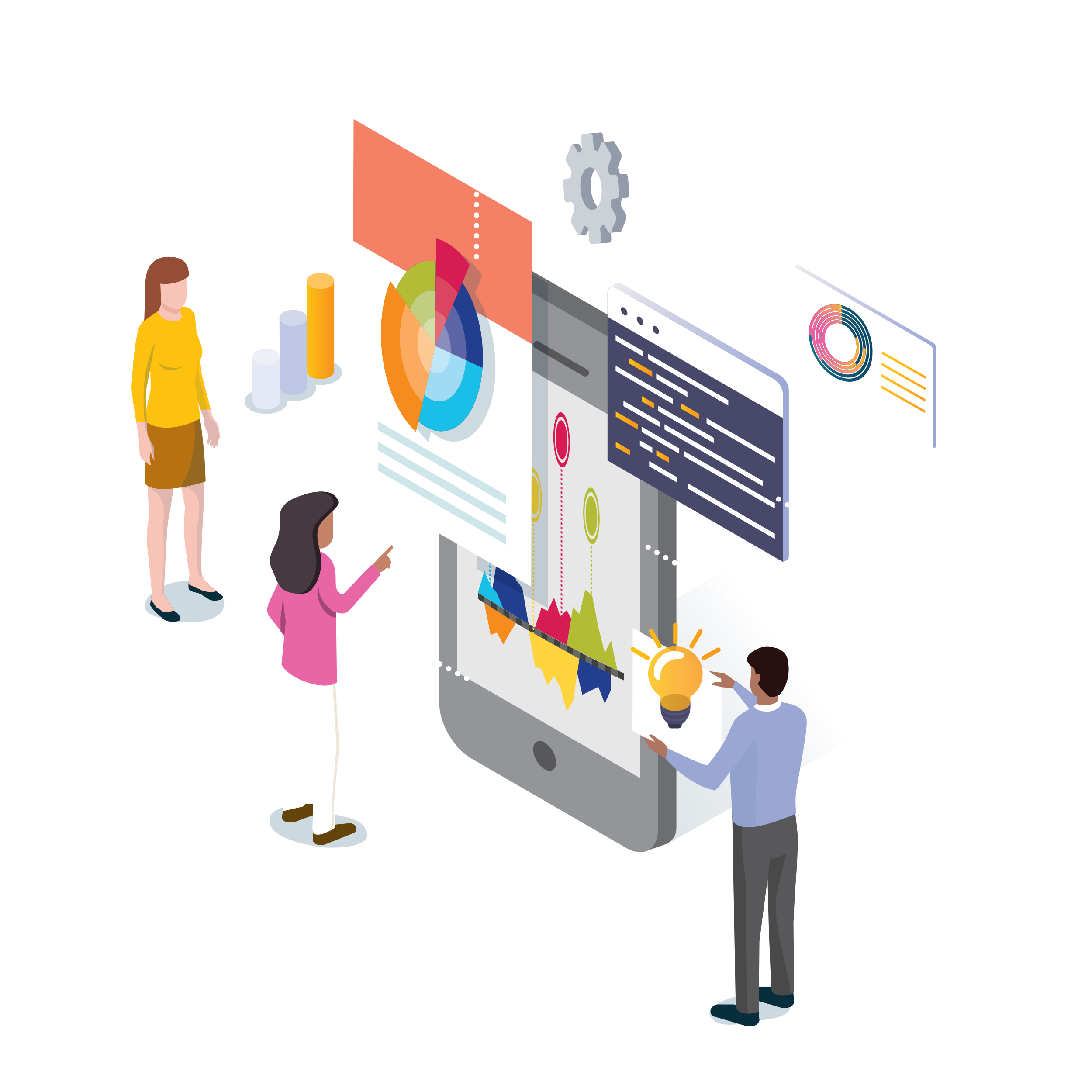
Hover to see how factors connect to Long-term Memory. Then click connected factors to explore strategies related to multiple factors.
Long-term Memory can store information indefinitely. We can move skills and knowledge into Long-term Memory by repeatedly practicing and using them. The Background Knowledge and Vocabulary stored in Long-term Memory provide students with a strong foundation for their reading and writing assignments.
When short-term memories are rehearsed, they become consolidated and move to Long-term Memory.
Explicit (Declarative) Long-term Memory stores the memories that can be consciously remembered.
Implicit (Nondeclarative) Long-term Memory stores the memories that do not require conscious thought.
Schemas exist in Long-term Memory as an organizational system for our current knowledge and provide a framework for adding future understanding. New information that comes into our Long-term Memory may be more readily encoded in memory when it is consistent with a current schema making learning easier when we have the appropriate Background Knowledge as context.
Physically acting out a text enhances reading comprehension.
Project-based learning (PBL) actively engages learners in authentic tasks designed to create products that answer a given question or solve a problem.
Expressing ideas through visuals and audio, and understanding others' ideas in these forms, is as critical in today's world as traditional reading and writing.
Students activate more cognitive processes by exploring and representing their understandings in visual form.
When students explain their thinking process aloud, they recognize the strategies they use and solidify their understanding.
Visiting places connected to classroom learning provides opportunities to deepen understanding through firsthand experiences.
Games help students visualize how to connect one fact to another.
Playful activities can support the development of learners' Metacognition and also inspire their narratives and writing.
Response devices boost engagement by encouraging all students to answer every question.
Students practice making and finding meaning in their reading through a book club model.
Flexible grouping is a classroom practice that temporarily places students together in given groups to work together, with the purpose of achieving a given learning goal or activity.
When peers are able to work together to plan, draft, edit, and revise their compositions, their writing quality improves.
As students walk through stations working in small groups, the social and physical nature of the learning supports deeper understanding.
As students work with and process information by discussing, organizing, and sharing it together, they deepen their understanding.
When students explain to others, they deepen their understanding and gain confidence in their learning.
Students develop literacy skills by listening to and speaking with others in informal ways.
Writing conferences allow students to share, reflect on, and receive feedback about their writing, which promotes Motivation for revising.
Easy access to high frequency words promotes sight word recognition as students see the words repeatedly.
Rhyming, alliteration, and other sound devices reinforce language development by activating the mental processes that promote memory.
A mnemonic device is a creative way to support memory for new information using connections to current knowledge, for example by creating visuals, acronyms, or rhymes.
Cards with strategies for managing emotions help students remember how to act when faced with strong feelings.
Providing a story map ahead of time or having students create a map during or after reading helps learners understand and expand their Genre Knowledge.
A word wall helps build Vocabulary for reading fluidity.
When teachers provide explicit instruction in comprehension strategies and model when to use them, students learn how to flexibly apply them to make meaning of texts.
Explicitly teaching strategies for different genres, like narrative or persuasive writing, helps students write for different purposes and audiences.
Teaching students how to create and use strong keywords for Internet searching is critical for helping them know how to find accurate, relevant information.
Formal spelling instruction improves not only students' spelling skills but also their reading skills.
Seeing and using new words repeatedly and in many contexts is critical for Vocabulary acquisition.
Explicitly teaching strategies for planning, writing, and revising texts improves students' writing quality.
In guided inquiry, teachers help students use their own language for constructing knowledge by active listening and questioning.
Independent reading promotes literacy by emphasizing student choice with teacher support in selecting books, as well as by making time for free reading.
Instruction in multiple formats allows students to activate different cognitive skills to understand and remember the steps they are to take in their literacy work.
Helping students think about what they know about the topic of upcoming work helps activate their Background Knowledge or reveals gaps.
When students read models of the type of writing they are doing, they can identify effective elements to incorporate in their writing.
Through one-on-one conferences, teachers can provide individual support to each student to deepen comprehension and interest in reading.
A strengths-based approach is one where educators intentionally identify, communicate, and harness students' assets, across many aspects of the whole child, in order to empower them to flourish.
Checklists and rubrics help students develop their abilities to self-assess and revise their writing.
Journaling allows students to reflect on their thinking and feelings, process their learning, and connect new information to what they know.
Providing space and time for students to reflect is critical for moving what they have learned into Long-term Memory.
When students monitor their comprehension, performance, and use of strategies when reading and writing, they build their Metacognition.
Pre-assessments are tools or activities used before instruction begins to help educators understand what students already know, understand, or can do—and where they may need support.
Audiobooks allow students to hear fluent reading and to experience books above their reading skills.
Communication boards are displays of graphics (e.g., pictures, symbols, illustrations) and/or words where learners can gesture or point to the displays to extend their expressive language potential.
Dictionaries and thesauruses can serve as resources for students to expand their Vocabulary knowledge.
Dictation, also referred to as speech-to-text, an assistive communication technology that translates voice dictation to digital text, provides students with transcription difficulties the opportunity to participate in the writing process by allowing them to use their voice to generate and record ideas.
Adding gestures and motions to complement learning activates more cognitive processes for recall and understanding.
Full sentence manipulatives allow students to practice producing more complex Syntax and writing.
Providing physical representations of parts of a sentence activates learners' mental processes.
Brain breaks that include movement allow learners to refresh their thinking and focus on learning new information.
We take in information through all our senses.
Connecting information to music and dance can support Short-term and Long-term Memory by engaging auditory processes, Emotions, and physical activity.
Research shows physical activity improves focus and creativity.
Providing tools so learners can choose to listen to a text supports individual strengths and needs.
Tossing a ball, beanbag, or other small object activates physical focus in support of mental focus.
Visual supports, like text magnification, colored overlays, and guided reading strips, help students focus and properly track as they read.
Web-based dictionaries and thesauruses can serve as visual and audio resources for students to expand their Vocabulary knowledge.
Word sorts are multisensory activities that help learners identify patterns and group words based on different categories.
Multiple display spaces promote collaboration by allowing groups to share information easily as they work.
Multiple writing surfaces promote collaboration by allowing groups to share information easily as they work.
Books for vision differences support reading development for learners with visual needs.
Reading materials of varying complexity and levels are necessary for all students to experience success.
With figurative language and creative sentence structure, poetry supports the development of a deeper understanding of the different ways language makes meaning.
Daily review strengthens previous learning and can lead to fluent recall.
Spending time with new content helps move concepts and ideas into Long-term Memory.
Practicing until achieving several error-free attempts is critical for retention.
Increasing how much students write improves both their writing and their reading.
Students build their confidence, strategy use, and comprehension by reading and rereading books.
Having students verbally repeat information such as instructions ensures they have heard the information and supports remembering.
Teachers support language development by using and providing Vocabulary that is appropriately leveled (e.g., using word wall words).
Chunking involves breaking texts down into more manageable pieces to help learners focus their Attention while reading and to comprehend text more effectively.
Providing constructive feedback supports students' writing development by letting them know how to improve their writing.
By talking through their thinking at each step of a process, teachers can model what learning looks like.
Reading aloud regularly exposes students to new and familiar Vocabulary and texts.
Reading aloud books about skills children are learning provides another model for their development.
Advance graphic organizers link prior knowledge to upcoming learning to help students anticipate and understand the structure of new information.
Visualizing how ideas fit together helps students construct meaning and strengthens their recall.
Visuals help students recognize relationships within words and sentences to develop literacy skills.
Sentence frames or stems provide language support for students' writing and participation in academic discussions.
Providing visuals to introduce, support, or review instruction activates more cognitive processes to support learning.
Videos developed with discussion guides can teach students about social and emotional learning (SEL) skills.
Selecting culturally responsive reading materials, including multicultural and diverse texts, is critical for supporting all students.
Learning about students' cultures and connecting them to instructional practices helps foster a sense of belonging and mitigate Stereotype Threat.
Translanguaging is a flexible classroom practice enabling students to listen, speak, read, and write across their multiple languages or dialects, even if the teacher does not have formal knowledge of these additional languages.
 Except where otherwise noted, content on this site is licensed under a Creative Commons Attribution-NonCommercial 4.0 International License
Except where otherwise noted, content on this site is licensed under a Creative Commons Attribution-NonCommercial 4.0 International License
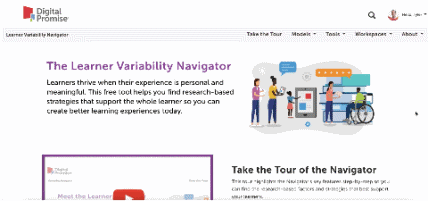
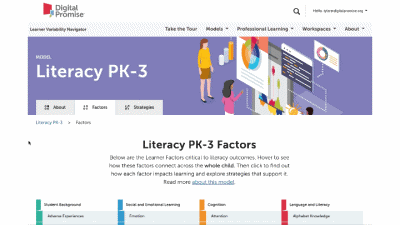
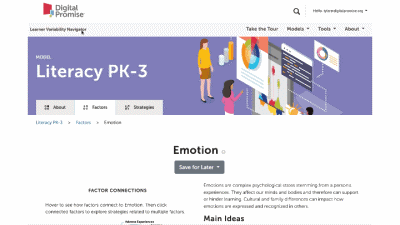
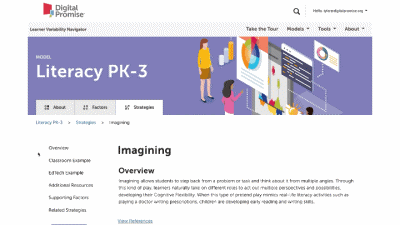
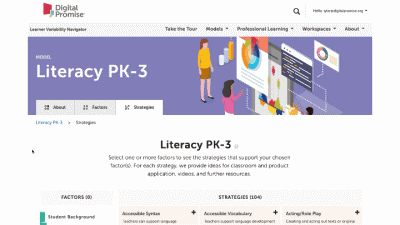
This is our homepage. You can access many of the features of the Navigator here, and learn more about how learner variability intersects with topics in education and learning. To start, select a content area – we call them Learner Models – to visit a factor map.
Factor maps show research-based concepts, "factors," that likely impact learning. They are organized into four categories: Learner Background, Social and Emotional Learning, Cognition, and Content Area. The map is interactive. Move your cursor over a factor to see connected factors. Select any factor to visit its summary page. We'll look at factor summary pages next.
This is a factor summary page. It provides a brief definition and review of the factor, a factor connections diagram, additional resources, and strategies that support this factor. On the strategy card, the multi-colored boxes show all the factors that it supports. Select a strategy to visit its summary page.
Strategy summary pages have an overview, information about using the strategy in different learning environments, resources of interest, the factors this strategy supports, and related strategies you can explore. To view all the strategies in a content area, use the strategies tab at the top of the page. We'll look at all the Strategies for this learner model next.
The strategy page shows ALL of the strategies for that learner model. You can select factors of interest for you or your learners, and it will narrow the strategies to only those that match all of the factors selected. This makes it easy to find key strategies to better design for learner variability. Again, select the strategy name to visit its summary page.
Are you sure you want to delete this Workspace?
Enter the email address of the person you want to share with. This person will be granted access to this workspace and will be able to view and edit it.
Adjust the permissions of your Workspace.
This Workspace is .
This Workspace's Reflection Area is .
Learner variability is the recognition that each learner is a unique constellation of strengths and challenges that are interconnected across the whole child. Understanding these connections and how they vary according to context is essential for meeting the needs of each learner.
It disrupts the notion of a one-size-fits all education. Understanding learner variability helps educators embrace both students’ struggles and strengths as we connect practice to uplifting the whole learner.
Throughout the site, we talk about "factors" and "strategies." Factors are concepts research suggests have an impact on how people learn. Strategies are the approaches to teaching and learning that can be used to support people in how they learn best.
Use the Learner Centered Design Tool to build a workspace. Go to Learner Centered Design Tool.
Or, create a new blank workspace for your product or project.
Use one of the guided tools to build a workspace.
Or, create a new blank workspace for your product or project.
Make a copy of this workspace.
Redirecting soon...
Generating summary page
Loading...
On this page, using your heatmap, you will be asked to select factors to further explore, and then select new strategies you might incorporate into upcoming instruction. Once done, click “Show Summary" to view your Design Summary Report.
On this page, using your heatmap, you will be asked to select factors to further explore, and then select new strategies you might incorporate into upcoming instruction. Once done, click “Show Report” to view your Design Summary Report.
By selecting "Show Report" you will be taken to the Assessment Summary Page. Once created, you will not be able to edit your report. If you select cancel below, you can continue to edit your factor and strategy selections.
Announcement here
Item successfully added to workspace!
Issue adding item to workspace. Please refresh the page and try again.
Learner variability is the recognition that each learner is a unique constellation of strengths and challenges that are interconnected across the whole child. Understanding these connections and how they vary according to context is essential for meeting the needs of each learner. It embraces both students’ struggles and strengths. It considers the whole child.
Throughout the site, we talk about "factors" and "strategies." Factors are concepts research suggests have an impact on how people learn. Strategies are the approaches to teaching and learning that can be used to support people in how they learn best.
The Learner Variability Navigator is a free, online tool that translates the science of learner variability into factor maps and strategies that highlight connections across the whole learner. This puts the science of learning at teachers' fingertips, empowering them to understand their own practice and support each learner.